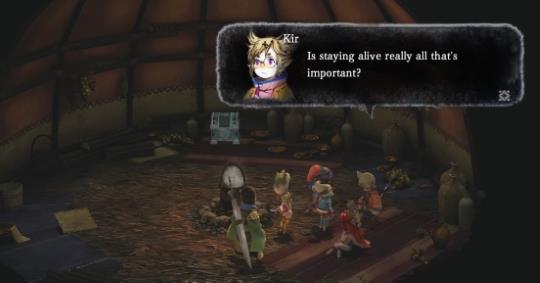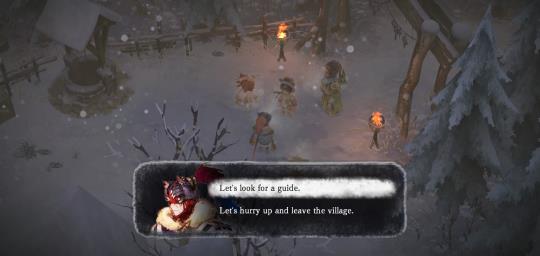I Am Setsuna

What is a life worth?
Leaning back in this uncomfortable wooden coffee shop chair, teeth gnawing at my lower lip as prog-rock beats and melodies pump into my ears, I ponder what the point of I Am Setsuna was.
I’ve skimmed, glanced, and hummed over a number of forum and blog responses to the game, and it turns out the disappointment experienced over on GamersWithJobs was rather tame compared to the rest of the Internet. For many, the ending seemed pointless, confusing, and lacking in concrete closure. For me, the final shot elicited an obnoxious laugh and declaration that it was “Japan as f**k”.
It’s only in ruminating on one simple choice that I realize what simple idea envelops I Am Setsuna like a blanket.
Swing your sword.
Do not swing your sword.
Two options given at the start of the game to the masked mercenary Endir, and by extension to the player character. It’s a choice that is partially misleading, and the perceived meaninglessness of the game’s choices are what have kindled disappointment and even anger at Tokyo RPG Factory’s debut outing. No matter what dialogue selections you make throughout I Am Setsuna, the game will progress upon a linear path. You’re either already in agreement with the rest of the party, or you’re constantly in disagreement but following along anyway.
The call to swing or stay Endir’s blade is no different. No matter what you decide, Endir will sheathe his sword. The game follows with the simple declaration that there’s no point in killing a sacrifice. She’s going to die regardless.
I don’t want to call it a misdirection, but the very narrative of the game will call the rationale into question. If you wanted to summarize I Am Setsuna with an axiom or cliché, then it would be that it’s “the journey, not the destination”.

“Why kill a woman that’s bound for death?” The game begins to answer its own question by illustrating the impact of Setsuna’s character. Admittedly, such absolute goodness can be frustrating due to how prevalent it is in anime and JRPGs. The young woman that touches everyone’s hearts with such selfless love and care. This was perhaps my first disappointment with the game as I had hoped instead for a more fatalistic Setsuna. For whatever reason, the initial trailers gave me the impression that the young woman would be resigned to her fate, and perhaps in search of meaning to her life rather than already convinced by her duty.
The saving grace in I Am Setsuna is that her caring character does not exist for the sake of love interests or appealing to player preferences. Setsuna is who she is for the sake of the narrative and its theme. Every character is in some way affected by Setsuna’s actions. Nadr, a veteran of a failed sacrificial pilgrimage, chooses to try again as Setsuna’s guard rather than cowardly hiding from his past failures and consequences. Warrior Princess Julienne is effectively freed from the poison prison suffered as a consequence to continue living.
The themes of a life’s worth are perhaps strongest and most parallel with child mage Kir. Born of a race with monstrous blood, the endangered clan of magicians must sacrifice much of their magical power for increased longevity. However, in order to seek out answers, protect Setsuna, and live a meaningful life, Kir makes the choice to burn the wick of his life as bright as possible regardless of the cost to his lifespan. A longer life spent accomplishing nothing is a worse fate than a shorter life spent making an impact.
Why bother slaying a woman that is already going to die? Because there’s so much she can accomplish in that short span of time.
As stated, I Am Setsuna has a tendency to muddle this theme a bit by offering the player choices. By game’s end it is supposed to be clear that Endir’s presence is key to the journey’s success, but many of Endir’s choices could have potentially sabotaged it. Similarly, many of these options fail to feed into the game’s theme transparently.

To this end I have to wonder if I Am Setsuna was doomed to disappoint from the start. Yes, there are other factors as well, such as the lack of clarity in the game’s mechanics – a topic I’ll be touching on tomorrow in a separate essay. It’s also hard not to compare with a title like Bravely Default, releasing at the same price-point but with far more effort put into presentation and graphical assets.
Even if the game were mechanically disappointing, a strong narrative can save it. Unfortunately when Western players are given choices in a game, they expect that choice to make some sort of difference. When the choice is obviously meaningless, they become frustrated or infuriated.
Honestly, if there is a flaw in these choices, it is that they muddle the concepts being portrayed at the game’s end. There’s a sense of predestination about everything, in which case Endir’s input is meaningless. Yet Endir’s presence is also supposed to be key to the game’s events. So to that end, what do the choices represent? If there is a greater destiny, then how can one man’s inclusion change the course of time? Perhaps it would have been better if Tokyo RPG Factory simply left only the first and final choices within the game. I think players would have responded more positively then.
It saddens me that the story for I Am Setsuna is so often referred to as a disappointment. In hindsight, the narrative is the reason I would want to go back rather than simply move onward to Tokyo RPG Factory’s second title Lost Sphear. Now that I have a solid grasp on its theme, I would want to look for all the small indicators that clue the player in to what its core concept is. I’d want to more thoroughly study each character and how they better illustrate the game’s ideas.
Instead, I Am Setsuna will instead live on in the minds of many as a half-baked Chrono Trigger, and that is not a suitable representation of what this game is.


